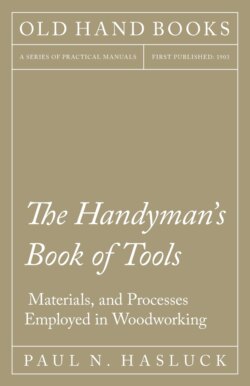Читать книгу The Handyman's Book of Tools, Materials, and Processes Employed in Woodworking - Paul N. Hasluck - Страница 114
На сайте Литреса книга снята с продажи.
HISTORY OF THE HAMMER.
ОглавлениеThe hammer is the most ancient of tools, and in all parts of the world and amongst all people hammers are in use. Even the name hammer seems to have a prehistoric origin, for it is common to all the northern languages. There is no tool more simple and more useful than the primitive or handicraft hammer. Indeed, so simple has it been esteemed that it does not possess any literature. The only mechanical tools for external use with which man is provided by nature are the hammer, a compound vice, and a scratching or scraping tool. These are in the hand; and none of the various compound tools introduced from time to time has surpassed in comprehensiveness of variety these three in one. However, as a hammer only can it now be discussed. Whilst for impact upon a substance softer than itself the fist can deal an appreciable blow, yet upon one harder than itself the reaction of the substance transfers the blow to the flesh and bone, and as a hammer the fist then is useless. Hence, amongst prehistoric contrivances, perhaps the first to be invented was the stone hammer-head, shaped, it may be supposed, by the action of water, and so rounded as to fit the hand. These stones are called by antiquarians “mauls,” and they were probably held in the hollow of the hand, and used on objects which otherwise could not have been broken. Mauls represent the original hammer. It may be assumed that occasionally the mauls proved too heavy, but more frequently too light; and obviously on very heavy work the holding of the stone in the hollow of the hand, and striking blows with it, caused a reaction which was mainly met by the muscular action of the back of the hand and of the thinnest section of the wrist; this would be not only fatiguing, but injurious, and it may have been that such effects led to the invention of double-ended mauls, which were held by the middle. A blow given by one of these is counteracted not only by the increased mass of material, but by the changed position of the hand and wrist in relation to the direction of the blow. When held in the hollow of the hand, the resistance was met by (say) a depth of tissue of about three-quarters of an inch, but when it was grasped round its middle the resistance was met by a depth of tissue of about three inches. Hence, whilst mechanically (owing to the mass of stone) and muscularly (owing to the position of the hand in reference to the direction of the blow) the maul in this second stage was a decided improvement upon the first, yet it must be admitted that experience would soon suggest that even thus there was wanting sufficient energy to overcome resistances, and that the double-headed maul might be improved. This, at any rate, will be admitted by anyone who has been obliged to use a stone in the hand as a hammer. Even the prehistoric races knew that whilst the hand possessed inimitable contrivances for grasping, and the arm for rapid motions, both jointly failed in giving the maul the power that often would be required. Ingenuity so far busied itself as to lash withes round such mauls as were found suitable—much after the manner in which present day blacksmiths lash withes round the heads of cutting and punching tools and swages. There are traces of even a higher advance, for what seem stone mauls, or hammers, are found with holes through them, suitable for handles, and holes are, in some instances, coned, and as well adapted for hammer handles as the best-made metal tools of these days. One such stone hammer-head was found in the river Thames, and is now in the British Museum. In this, the double-coned hole for the attachment and wedging-up of a handle is formed admirably, and the shape of the hammer is worthy of much commendation. How the ancients fixed a handle in a double-coned hole in a stone maul is more than is known now, but antiquarians surmise that having found the branch of a tree about the size of the smallest part of the eye of the maul, the stone was hung on it, and after a few years the growth of the tree fixed the handle in the maul, and then the branch was separated by a sharp stone implement, thus producing a hammer in which the shaft formed a perfect fit with the head.
Fig. 322.—Exeter or London Hammer.
Fig. 323.—Warrington Hammer.
Fig. 324.—Adze-eye Claw Hammer.
